MGT501 Business Environment: Woolworths Stakeholder Analysis
VerifiedAdded on 2022/11/26
|12
|3592
|92
Report
AI Summary
This report presents a comprehensive stakeholder analysis of Woolworths, a leading Australian supermarket chain. It identifies key stakeholders, including customers, government, investors, employees, and suppliers, and examines their respective interests and influence on the organization. The analysis explores the functional areas of Woolworths, such as human resources, operations, marketing, and customer service, and assesses the nature and degree of stakeholder interests, along with the implications of conflicting interests. The report highlights the significant influence of government, customers, and suppliers on Woolworths' operations and decision-making. It also discusses Woolworths' innovative approaches to satisfy its diverse stakeholders and maintain a strong brand image. The analysis further explores the internal and external stakeholders, their financial interests, and the ethical considerations that Woolworths prioritizes to maintain healthy relationships and ensure ethical business practices. The report concludes by emphasizing the importance of understanding stakeholder dynamics for the success and sustainability of Woolworths in the competitive Australian retail market.
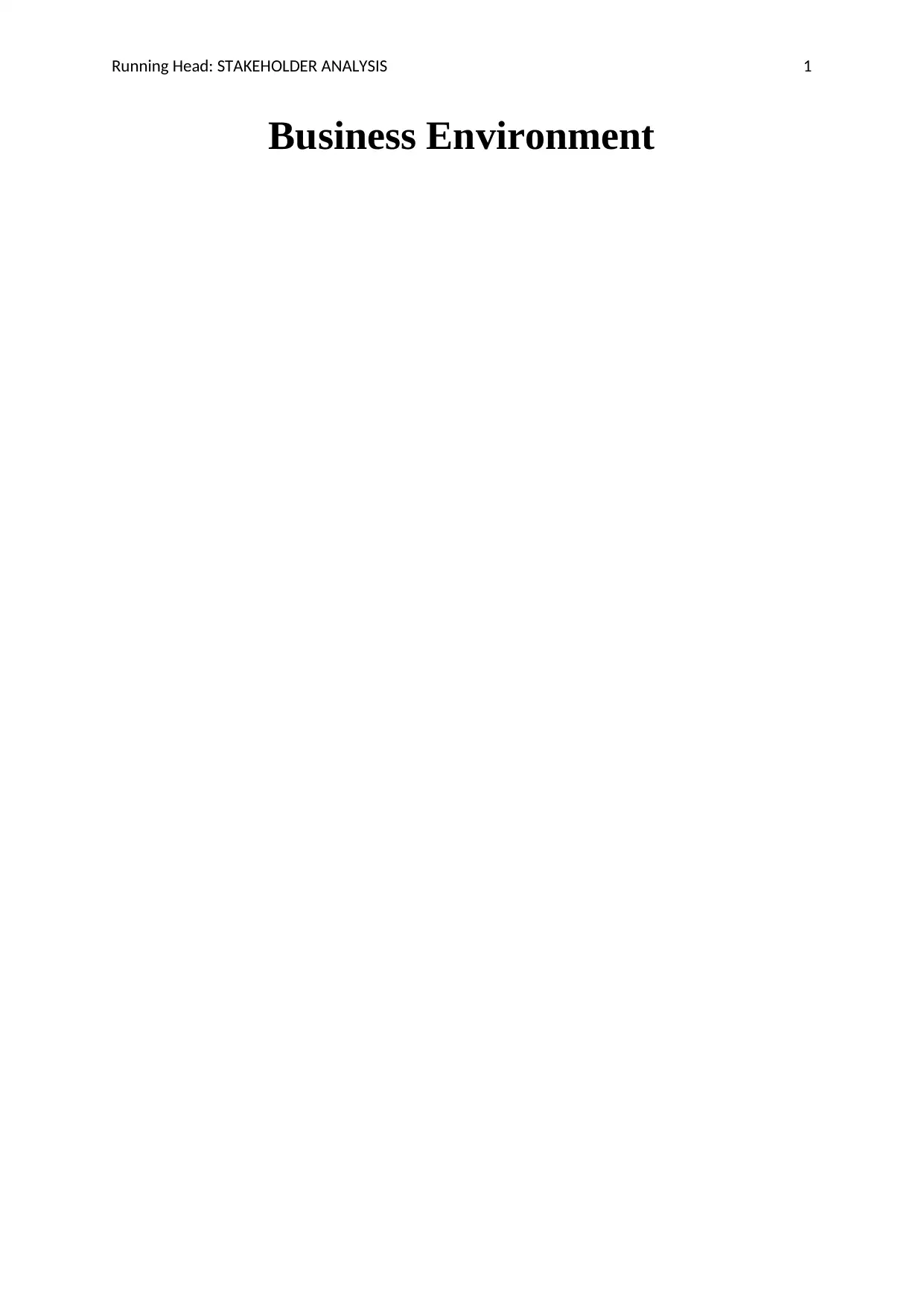
Running Head: STAKEHOLDER ANALYSIS 1
Business Environment
Business Environment
Paraphrase This Document
Need a fresh take? Get an instant paraphrase of this document with our AI Paraphraser
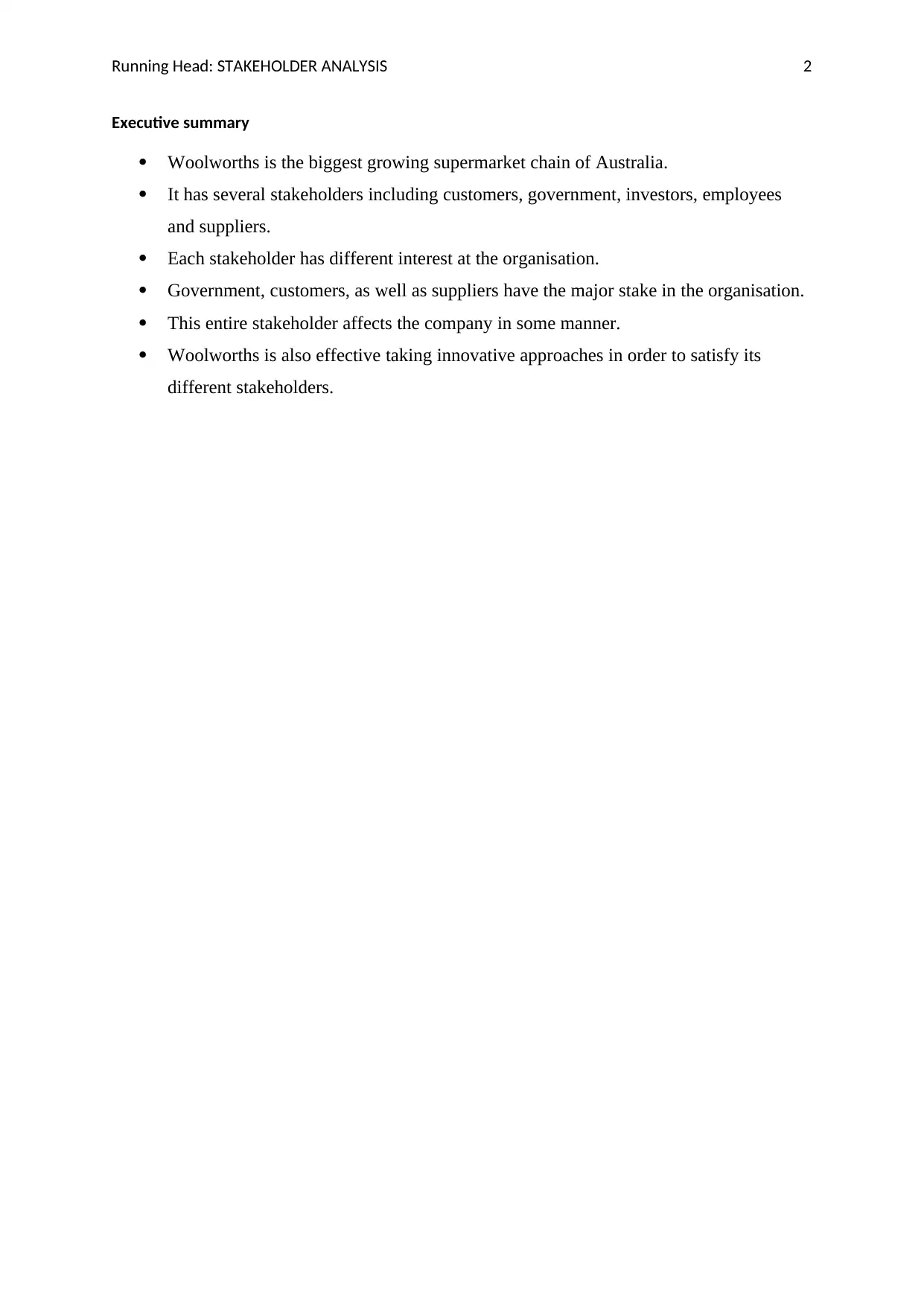
Running Head: STAKEHOLDER ANALYSIS 2
Executive summary
Woolworths is the biggest growing supermarket chain of Australia.
It has several stakeholders including customers, government, investors, employees
and suppliers.
Each stakeholder has different interest at the organisation.
Government, customers, as well as suppliers have the major stake in the organisation.
This entire stakeholder affects the company in some manner.
Woolworths is also effective taking innovative approaches in order to satisfy its
different stakeholders.
Executive summary
Woolworths is the biggest growing supermarket chain of Australia.
It has several stakeholders including customers, government, investors, employees
and suppliers.
Each stakeholder has different interest at the organisation.
Government, customers, as well as suppliers have the major stake in the organisation.
This entire stakeholder affects the company in some manner.
Woolworths is also effective taking innovative approaches in order to satisfy its
different stakeholders.
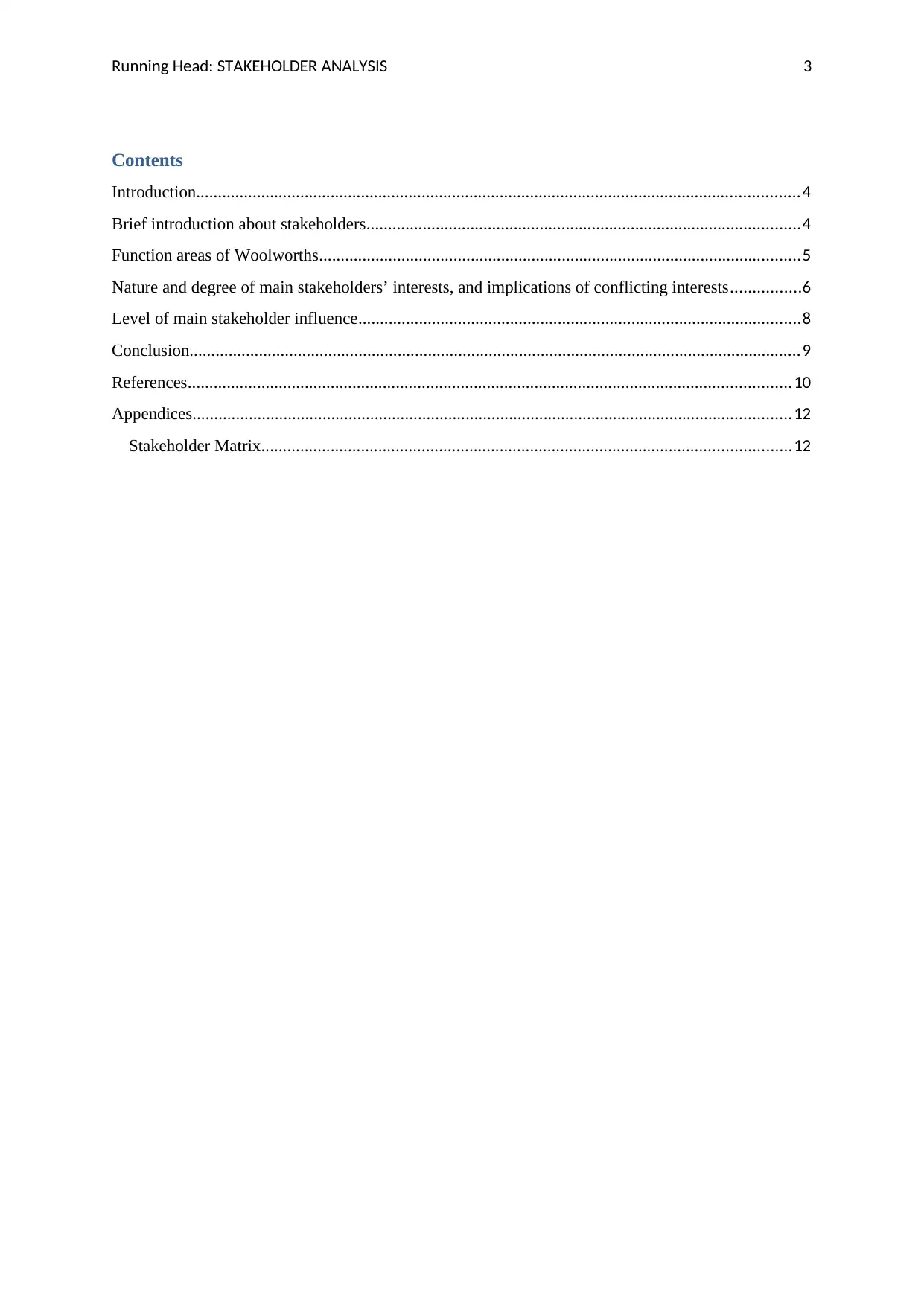
Running Head: STAKEHOLDER ANALYSIS 3
Contents
Introduction...........................................................................................................................................4
Brief introduction about stakeholders....................................................................................................4
Function areas of Woolworths...............................................................................................................5
Nature and degree of main stakeholders’ interests, and implications of conflicting interests................6
Level of main stakeholder influence......................................................................................................8
Conclusion.............................................................................................................................................9
References...........................................................................................................................................10
Appendices..........................................................................................................................................12
Stakeholder Matrix..........................................................................................................................12
Contents
Introduction...........................................................................................................................................4
Brief introduction about stakeholders....................................................................................................4
Function areas of Woolworths...............................................................................................................5
Nature and degree of main stakeholders’ interests, and implications of conflicting interests................6
Level of main stakeholder influence......................................................................................................8
Conclusion.............................................................................................................................................9
References...........................................................................................................................................10
Appendices..........................................................................................................................................12
Stakeholder Matrix..........................................................................................................................12
⊘ This is a preview!⊘
Do you want full access?
Subscribe today to unlock all pages.

Trusted by 1+ million students worldwide
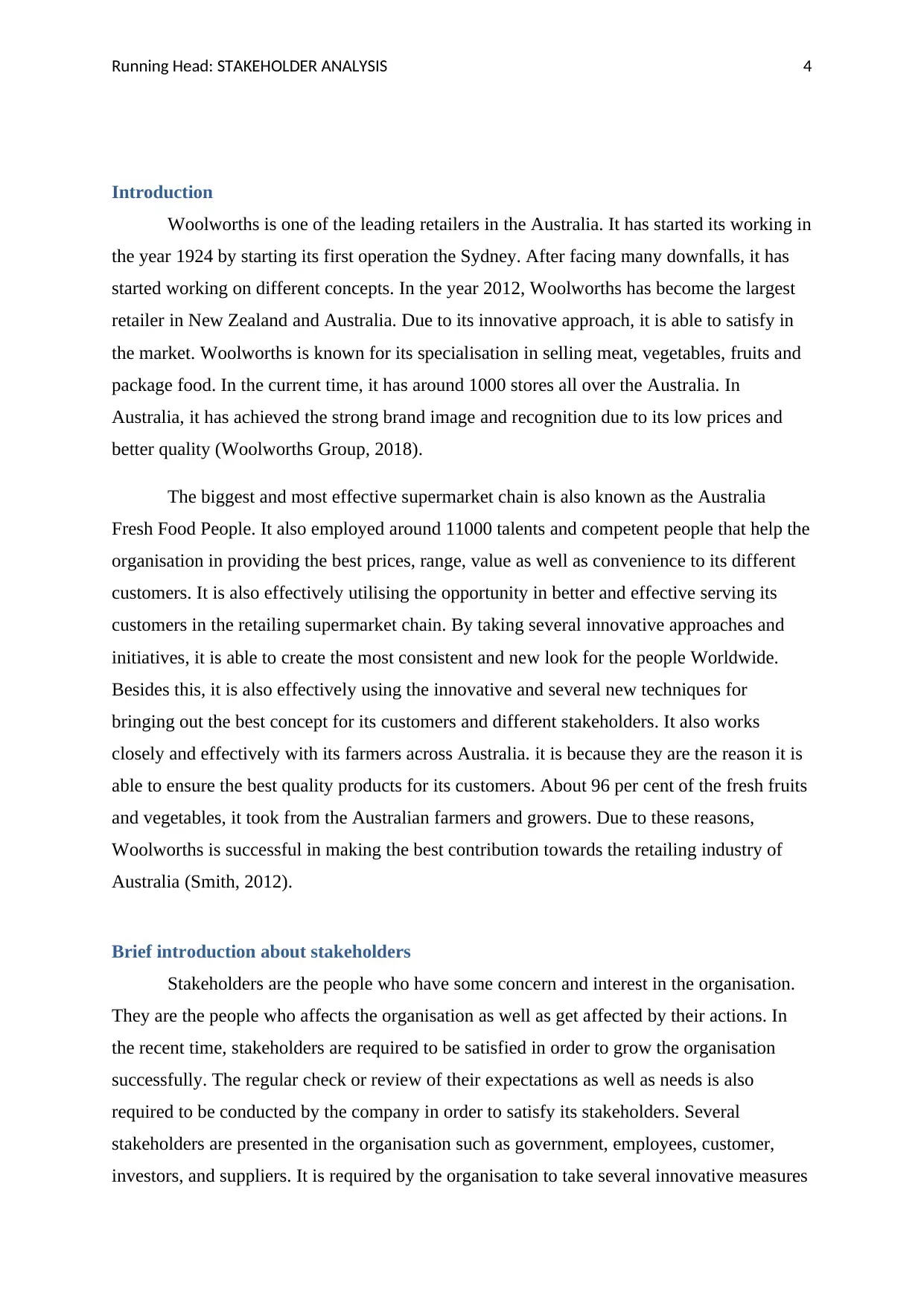
Running Head: STAKEHOLDER ANALYSIS 4
Introduction
Woolworths is one of the leading retailers in the Australia. It has started its working in
the year 1924 by starting its first operation the Sydney. After facing many downfalls, it has
started working on different concepts. In the year 2012, Woolworths has become the largest
retailer in New Zealand and Australia. Due to its innovative approach, it is able to satisfy in
the market. Woolworths is known for its specialisation in selling meat, vegetables, fruits and
package food. In the current time, it has around 1000 stores all over the Australia. In
Australia, it has achieved the strong brand image and recognition due to its low prices and
better quality (Woolworths Group, 2018).
The biggest and most effective supermarket chain is also known as the Australia
Fresh Food People. It also employed around 11000 talents and competent people that help the
organisation in providing the best prices, range, value as well as convenience to its different
customers. It is also effectively utilising the opportunity in better and effective serving its
customers in the retailing supermarket chain. By taking several innovative approaches and
initiatives, it is able to create the most consistent and new look for the people Worldwide.
Besides this, it is also effectively using the innovative and several new techniques for
bringing out the best concept for its customers and different stakeholders. It also works
closely and effectively with its farmers across Australia. it is because they are the reason it is
able to ensure the best quality products for its customers. About 96 per cent of the fresh fruits
and vegetables, it took from the Australian farmers and growers. Due to these reasons,
Woolworths is successful in making the best contribution towards the retailing industry of
Australia (Smith, 2012).
Brief introduction about stakeholders
Stakeholders are the people who have some concern and interest in the organisation.
They are the people who affects the organisation as well as get affected by their actions. In
the recent time, stakeholders are required to be satisfied in order to grow the organisation
successfully. The regular check or review of their expectations as well as needs is also
required to be conducted by the company in order to satisfy its stakeholders. Several
stakeholders are presented in the organisation such as government, employees, customer,
investors, and suppliers. It is required by the organisation to take several innovative measures
Introduction
Woolworths is one of the leading retailers in the Australia. It has started its working in
the year 1924 by starting its first operation the Sydney. After facing many downfalls, it has
started working on different concepts. In the year 2012, Woolworths has become the largest
retailer in New Zealand and Australia. Due to its innovative approach, it is able to satisfy in
the market. Woolworths is known for its specialisation in selling meat, vegetables, fruits and
package food. In the current time, it has around 1000 stores all over the Australia. In
Australia, it has achieved the strong brand image and recognition due to its low prices and
better quality (Woolworths Group, 2018).
The biggest and most effective supermarket chain is also known as the Australia
Fresh Food People. It also employed around 11000 talents and competent people that help the
organisation in providing the best prices, range, value as well as convenience to its different
customers. It is also effectively utilising the opportunity in better and effective serving its
customers in the retailing supermarket chain. By taking several innovative approaches and
initiatives, it is able to create the most consistent and new look for the people Worldwide.
Besides this, it is also effectively using the innovative and several new techniques for
bringing out the best concept for its customers and different stakeholders. It also works
closely and effectively with its farmers across Australia. it is because they are the reason it is
able to ensure the best quality products for its customers. About 96 per cent of the fresh fruits
and vegetables, it took from the Australian farmers and growers. Due to these reasons,
Woolworths is successful in making the best contribution towards the retailing industry of
Australia (Smith, 2012).
Brief introduction about stakeholders
Stakeholders are the people who have some concern and interest in the organisation.
They are the people who affects the organisation as well as get affected by their actions. In
the recent time, stakeholders are required to be satisfied in order to grow the organisation
successfully. The regular check or review of their expectations as well as needs is also
required to be conducted by the company in order to satisfy its stakeholders. Several
stakeholders are presented in the organisation such as government, employees, customer,
investors, and suppliers. It is required by the organisation to take several innovative measures
Paraphrase This Document
Need a fresh take? Get an instant paraphrase of this document with our AI Paraphraser
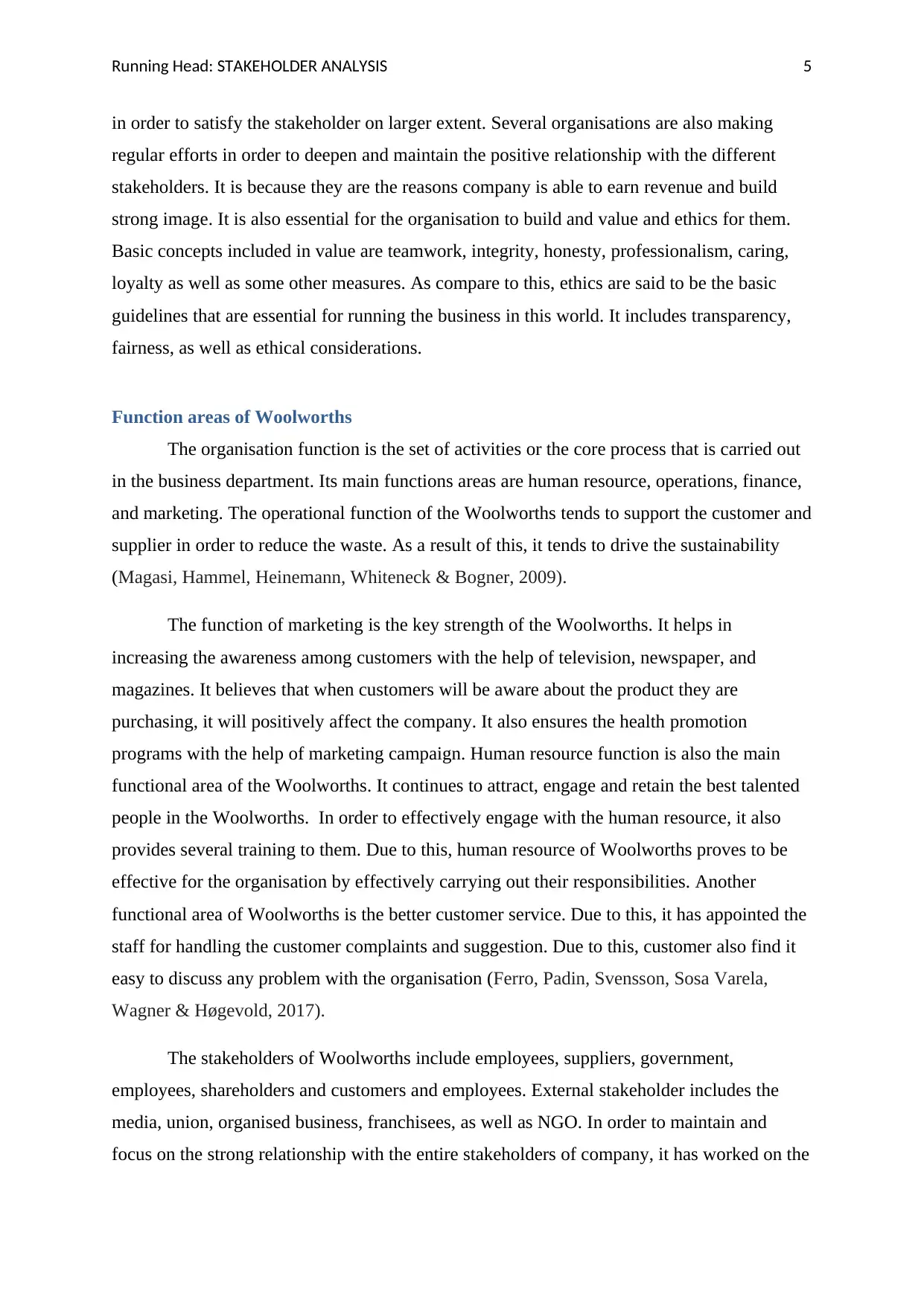
Running Head: STAKEHOLDER ANALYSIS 5
in order to satisfy the stakeholder on larger extent. Several organisations are also making
regular efforts in order to deepen and maintain the positive relationship with the different
stakeholders. It is because they are the reasons company is able to earn revenue and build
strong image. It is also essential for the organisation to build and value and ethics for them.
Basic concepts included in value are teamwork, integrity, honesty, professionalism, caring,
loyalty as well as some other measures. As compare to this, ethics are said to be the basic
guidelines that are essential for running the business in this world. It includes transparency,
fairness, as well as ethical considerations.
Function areas of Woolworths
The organisation function is the set of activities or the core process that is carried out
in the business department. Its main functions areas are human resource, operations, finance,
and marketing. The operational function of the Woolworths tends to support the customer and
supplier in order to reduce the waste. As a result of this, it tends to drive the sustainability
(Magasi, Hammel, Heinemann, Whiteneck & Bogner, 2009).
The function of marketing is the key strength of the Woolworths. It helps in
increasing the awareness among customers with the help of television, newspaper, and
magazines. It believes that when customers will be aware about the product they are
purchasing, it will positively affect the company. It also ensures the health promotion
programs with the help of marketing campaign. Human resource function is also the main
functional area of the Woolworths. It continues to attract, engage and retain the best talented
people in the Woolworths. In order to effectively engage with the human resource, it also
provides several training to them. Due to this, human resource of Woolworths proves to be
effective for the organisation by effectively carrying out their responsibilities. Another
functional area of Woolworths is the better customer service. Due to this, it has appointed the
staff for handling the customer complaints and suggestion. Due to this, customer also find it
easy to discuss any problem with the organisation (Ferro, Padin, Svensson, Sosa Varela,
Wagner & Høgevold, 2017).
The stakeholders of Woolworths include employees, suppliers, government,
employees, shareholders and customers and employees. External stakeholder includes the
media, union, organised business, franchisees, as well as NGO. In order to maintain and
focus on the strong relationship with the entire stakeholders of company, it has worked on the
in order to satisfy the stakeholder on larger extent. Several organisations are also making
regular efforts in order to deepen and maintain the positive relationship with the different
stakeholders. It is because they are the reasons company is able to earn revenue and build
strong image. It is also essential for the organisation to build and value and ethics for them.
Basic concepts included in value are teamwork, integrity, honesty, professionalism, caring,
loyalty as well as some other measures. As compare to this, ethics are said to be the basic
guidelines that are essential for running the business in this world. It includes transparency,
fairness, as well as ethical considerations.
Function areas of Woolworths
The organisation function is the set of activities or the core process that is carried out
in the business department. Its main functions areas are human resource, operations, finance,
and marketing. The operational function of the Woolworths tends to support the customer and
supplier in order to reduce the waste. As a result of this, it tends to drive the sustainability
(Magasi, Hammel, Heinemann, Whiteneck & Bogner, 2009).
The function of marketing is the key strength of the Woolworths. It helps in
increasing the awareness among customers with the help of television, newspaper, and
magazines. It believes that when customers will be aware about the product they are
purchasing, it will positively affect the company. It also ensures the health promotion
programs with the help of marketing campaign. Human resource function is also the main
functional area of the Woolworths. It continues to attract, engage and retain the best talented
people in the Woolworths. In order to effectively engage with the human resource, it also
provides several training to them. Due to this, human resource of Woolworths proves to be
effective for the organisation by effectively carrying out their responsibilities. Another
functional area of Woolworths is the better customer service. Due to this, it has appointed the
staff for handling the customer complaints and suggestion. Due to this, customer also find it
easy to discuss any problem with the organisation (Ferro, Padin, Svensson, Sosa Varela,
Wagner & Høgevold, 2017).
The stakeholders of Woolworths include employees, suppliers, government,
employees, shareholders and customers and employees. External stakeholder includes the
media, union, organised business, franchisees, as well as NGO. In order to maintain and
focus on the strong relationship with the entire stakeholders of company, it has worked on the
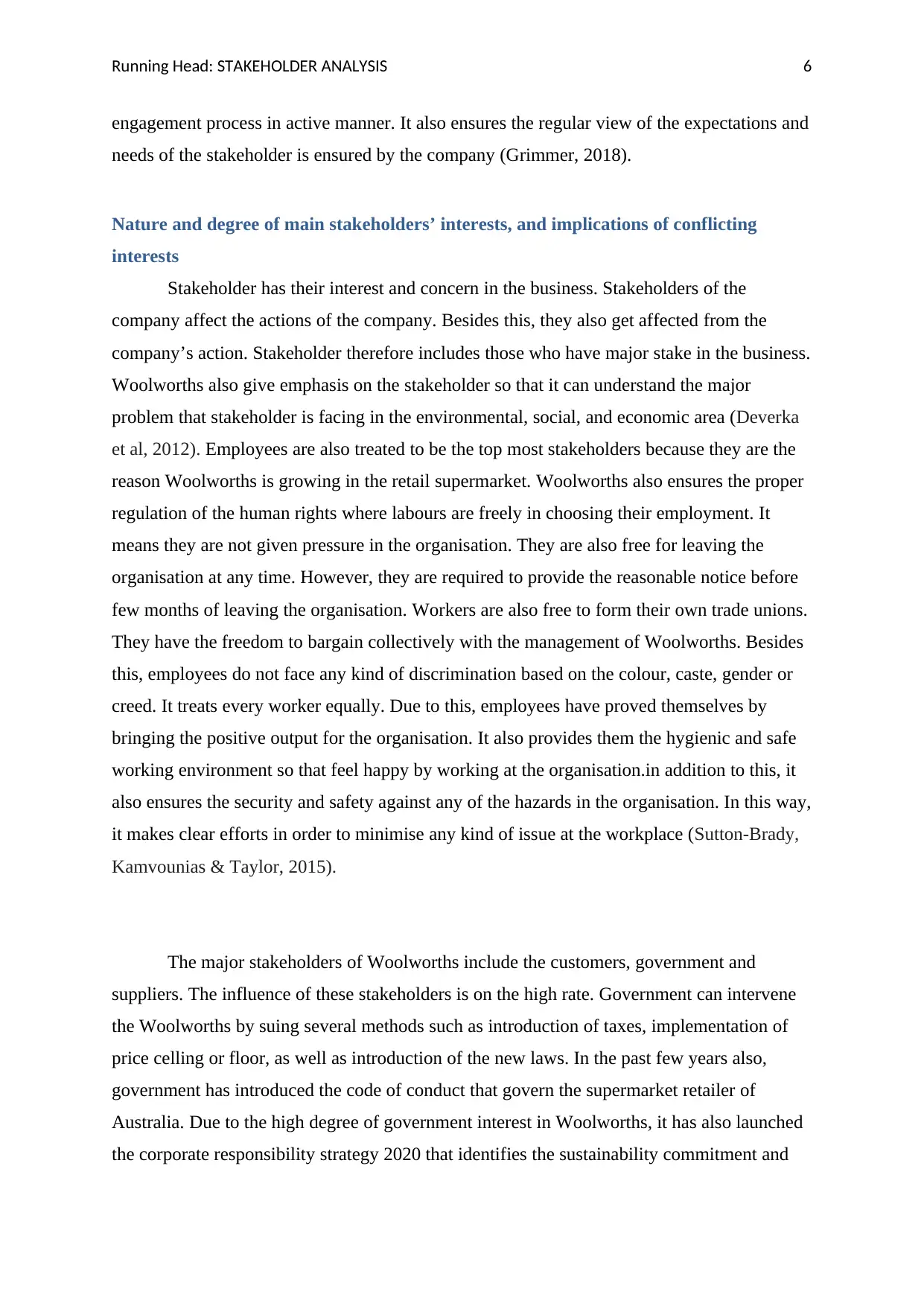
Running Head: STAKEHOLDER ANALYSIS 6
engagement process in active manner. It also ensures the regular view of the expectations and
needs of the stakeholder is ensured by the company (Grimmer, 2018).
Nature and degree of main stakeholders’ interests, and implications of conflicting
interests
Stakeholder has their interest and concern in the business. Stakeholders of the
company affect the actions of the company. Besides this, they also get affected from the
company’s action. Stakeholder therefore includes those who have major stake in the business.
Woolworths also give emphasis on the stakeholder so that it can understand the major
problem that stakeholder is facing in the environmental, social, and economic area (Deverka
et al, 2012). Employees are also treated to be the top most stakeholders because they are the
reason Woolworths is growing in the retail supermarket. Woolworths also ensures the proper
regulation of the human rights where labours are freely in choosing their employment. It
means they are not given pressure in the organisation. They are also free for leaving the
organisation at any time. However, they are required to provide the reasonable notice before
few months of leaving the organisation. Workers are also free to form their own trade unions.
They have the freedom to bargain collectively with the management of Woolworths. Besides
this, employees do not face any kind of discrimination based on the colour, caste, gender or
creed. It treats every worker equally. Due to this, employees have proved themselves by
bringing the positive output for the organisation. It also provides them the hygienic and safe
working environment so that feel happy by working at the organisation.in addition to this, it
also ensures the security and safety against any of the hazards in the organisation. In this way,
it makes clear efforts in order to minimise any kind of issue at the workplace (Sutton-Brady,
Kamvounias & Taylor, 2015).
The major stakeholders of Woolworths include the customers, government and
suppliers. The influence of these stakeholders is on the high rate. Government can intervene
the Woolworths by suing several methods such as introduction of taxes, implementation of
price celling or floor, as well as introduction of the new laws. In the past few years also,
government has introduced the code of conduct that govern the supermarket retailer of
Australia. Due to the high degree of government interest in Woolworths, it has also launched
the corporate responsibility strategy 2020 that identifies the sustainability commitment and
engagement process in active manner. It also ensures the regular view of the expectations and
needs of the stakeholder is ensured by the company (Grimmer, 2018).
Nature and degree of main stakeholders’ interests, and implications of conflicting
interests
Stakeholder has their interest and concern in the business. Stakeholders of the
company affect the actions of the company. Besides this, they also get affected from the
company’s action. Stakeholder therefore includes those who have major stake in the business.
Woolworths also give emphasis on the stakeholder so that it can understand the major
problem that stakeholder is facing in the environmental, social, and economic area (Deverka
et al, 2012). Employees are also treated to be the top most stakeholders because they are the
reason Woolworths is growing in the retail supermarket. Woolworths also ensures the proper
regulation of the human rights where labours are freely in choosing their employment. It
means they are not given pressure in the organisation. They are also free for leaving the
organisation at any time. However, they are required to provide the reasonable notice before
few months of leaving the organisation. Workers are also free to form their own trade unions.
They have the freedom to bargain collectively with the management of Woolworths. Besides
this, employees do not face any kind of discrimination based on the colour, caste, gender or
creed. It treats every worker equally. Due to this, employees have proved themselves by
bringing the positive output for the organisation. It also provides them the hygienic and safe
working environment so that feel happy by working at the organisation.in addition to this, it
also ensures the security and safety against any of the hazards in the organisation. In this way,
it makes clear efforts in order to minimise any kind of issue at the workplace (Sutton-Brady,
Kamvounias & Taylor, 2015).
The major stakeholders of Woolworths include the customers, government and
suppliers. The influence of these stakeholders is on the high rate. Government can intervene
the Woolworths by suing several methods such as introduction of taxes, implementation of
price celling or floor, as well as introduction of the new laws. In the past few years also,
government has introduced the code of conduct that govern the supermarket retailer of
Australia. Due to the high degree of government interest in Woolworths, it has also launched
the corporate responsibility strategy 2020 that identifies the sustainability commitment and
⊘ This is a preview!⊘
Do you want full access?
Subscribe today to unlock all pages.

Trusted by 1+ million students worldwide
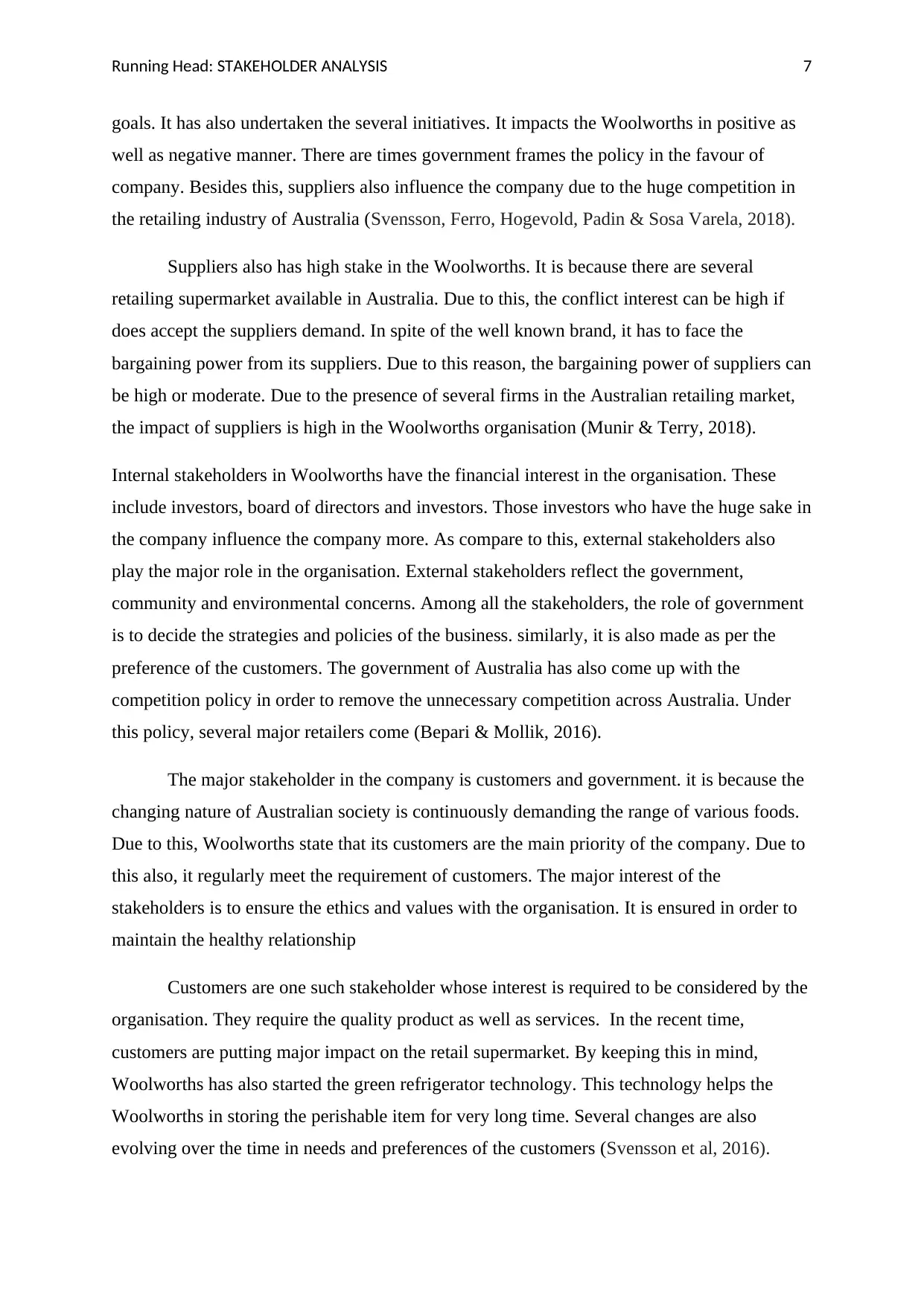
Running Head: STAKEHOLDER ANALYSIS 7
goals. It has also undertaken the several initiatives. It impacts the Woolworths in positive as
well as negative manner. There are times government frames the policy in the favour of
company. Besides this, suppliers also influence the company due to the huge competition in
the retailing industry of Australia (Svensson, Ferro, Hogevold, Padin & Sosa Varela, 2018).
Suppliers also has high stake in the Woolworths. It is because there are several
retailing supermarket available in Australia. Due to this, the conflict interest can be high if
does accept the suppliers demand. In spite of the well known brand, it has to face the
bargaining power from its suppliers. Due to this reason, the bargaining power of suppliers can
be high or moderate. Due to the presence of several firms in the Australian retailing market,
the impact of suppliers is high in the Woolworths organisation (Munir & Terry, 2018).
Internal stakeholders in Woolworths have the financial interest in the organisation. These
include investors, board of directors and investors. Those investors who have the huge sake in
the company influence the company more. As compare to this, external stakeholders also
play the major role in the organisation. External stakeholders reflect the government,
community and environmental concerns. Among all the stakeholders, the role of government
is to decide the strategies and policies of the business. similarly, it is also made as per the
preference of the customers. The government of Australia has also come up with the
competition policy in order to remove the unnecessary competition across Australia. Under
this policy, several major retailers come (Bepari & Mollik, 2016).
The major stakeholder in the company is customers and government. it is because the
changing nature of Australian society is continuously demanding the range of various foods.
Due to this, Woolworths state that its customers are the main priority of the company. Due to
this also, it regularly meet the requirement of customers. The major interest of the
stakeholders is to ensure the ethics and values with the organisation. It is ensured in order to
maintain the healthy relationship
Customers are one such stakeholder whose interest is required to be considered by the
organisation. They require the quality product as well as services. In the recent time,
customers are putting major impact on the retail supermarket. By keeping this in mind,
Woolworths has also started the green refrigerator technology. This technology helps the
Woolworths in storing the perishable item for very long time. Several changes are also
evolving over the time in needs and preferences of the customers (Svensson et al, 2016).
goals. It has also undertaken the several initiatives. It impacts the Woolworths in positive as
well as negative manner. There are times government frames the policy in the favour of
company. Besides this, suppliers also influence the company due to the huge competition in
the retailing industry of Australia (Svensson, Ferro, Hogevold, Padin & Sosa Varela, 2018).
Suppliers also has high stake in the Woolworths. It is because there are several
retailing supermarket available in Australia. Due to this, the conflict interest can be high if
does accept the suppliers demand. In spite of the well known brand, it has to face the
bargaining power from its suppliers. Due to this reason, the bargaining power of suppliers can
be high or moderate. Due to the presence of several firms in the Australian retailing market,
the impact of suppliers is high in the Woolworths organisation (Munir & Terry, 2018).
Internal stakeholders in Woolworths have the financial interest in the organisation. These
include investors, board of directors and investors. Those investors who have the huge sake in
the company influence the company more. As compare to this, external stakeholders also
play the major role in the organisation. External stakeholders reflect the government,
community and environmental concerns. Among all the stakeholders, the role of government
is to decide the strategies and policies of the business. similarly, it is also made as per the
preference of the customers. The government of Australia has also come up with the
competition policy in order to remove the unnecessary competition across Australia. Under
this policy, several major retailers come (Bepari & Mollik, 2016).
The major stakeholder in the company is customers and government. it is because the
changing nature of Australian society is continuously demanding the range of various foods.
Due to this, Woolworths state that its customers are the main priority of the company. Due to
this also, it regularly meet the requirement of customers. The major interest of the
stakeholders is to ensure the ethics and values with the organisation. It is ensured in order to
maintain the healthy relationship
Customers are one such stakeholder whose interest is required to be considered by the
organisation. They require the quality product as well as services. In the recent time,
customers are putting major impact on the retail supermarket. By keeping this in mind,
Woolworths has also started the green refrigerator technology. This technology helps the
Woolworths in storing the perishable item for very long time. Several changes are also
evolving over the time in needs and preferences of the customers (Svensson et al, 2016).
Paraphrase This Document
Need a fresh take? Get an instant paraphrase of this document with our AI Paraphraser
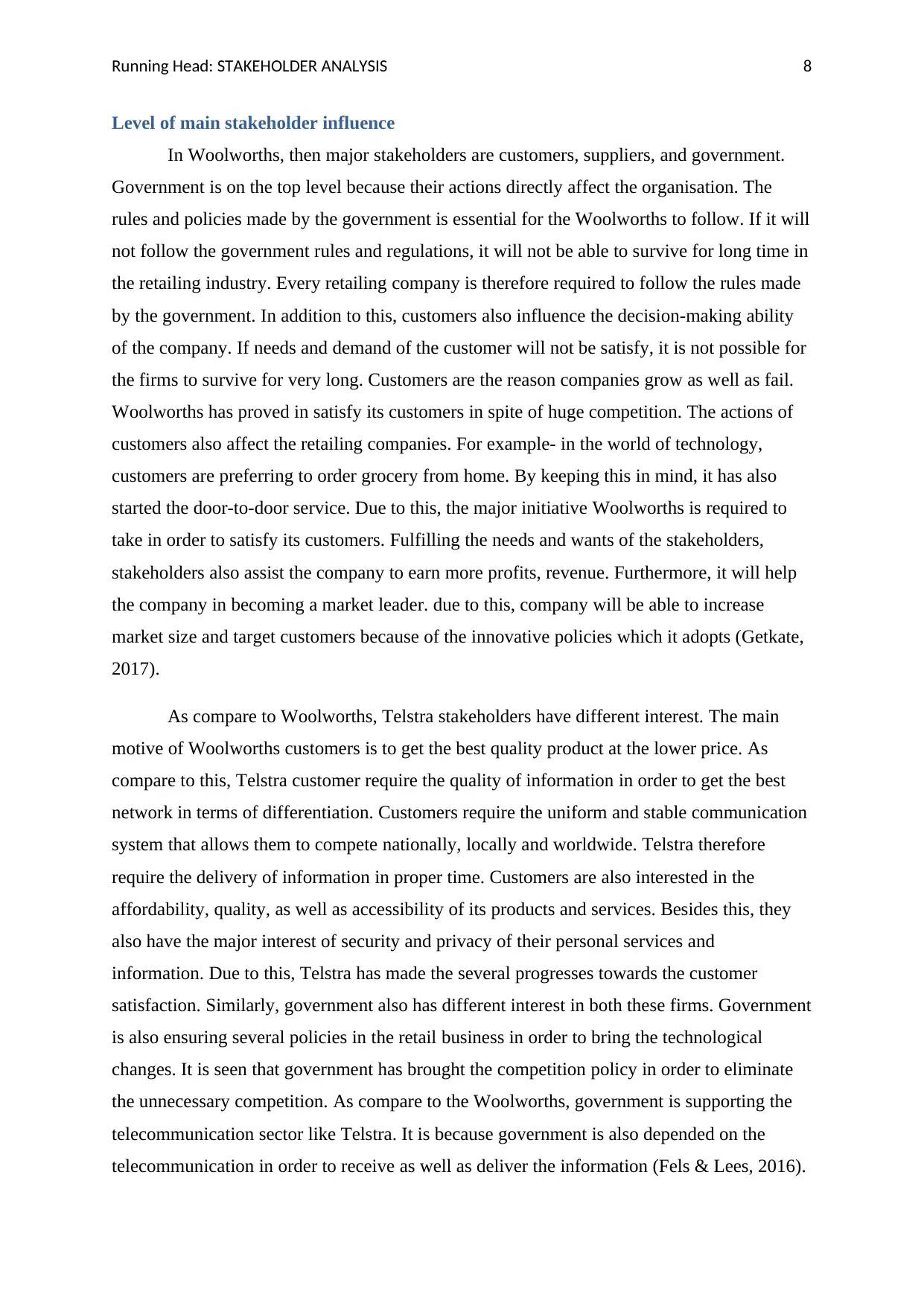
Running Head: STAKEHOLDER ANALYSIS 8
Level of main stakeholder influence
In Woolworths, then major stakeholders are customers, suppliers, and government.
Government is on the top level because their actions directly affect the organisation. The
rules and policies made by the government is essential for the Woolworths to follow. If it will
not follow the government rules and regulations, it will not be able to survive for long time in
the retailing industry. Every retailing company is therefore required to follow the rules made
by the government. In addition to this, customers also influence the decision-making ability
of the company. If needs and demand of the customer will not be satisfy, it is not possible for
the firms to survive for very long. Customers are the reason companies grow as well as fail.
Woolworths has proved in satisfy its customers in spite of huge competition. The actions of
customers also affect the retailing companies. For example- in the world of technology,
customers are preferring to order grocery from home. By keeping this in mind, it has also
started the door-to-door service. Due to this, the major initiative Woolworths is required to
take in order to satisfy its customers. Fulfilling the needs and wants of the stakeholders,
stakeholders also assist the company to earn more profits, revenue. Furthermore, it will help
the company in becoming a market leader. due to this, company will be able to increase
market size and target customers because of the innovative policies which it adopts (Getkate,
2017).
As compare to Woolworths, Telstra stakeholders have different interest. The main
motive of Woolworths customers is to get the best quality product at the lower price. As
compare to this, Telstra customer require the quality of information in order to get the best
network in terms of differentiation. Customers require the uniform and stable communication
system that allows them to compete nationally, locally and worldwide. Telstra therefore
require the delivery of information in proper time. Customers are also interested in the
affordability, quality, as well as accessibility of its products and services. Besides this, they
also have the major interest of security and privacy of their personal services and
information. Due to this, Telstra has made the several progresses towards the customer
satisfaction. Similarly, government also has different interest in both these firms. Government
is also ensuring several policies in the retail business in order to bring the technological
changes. It is seen that government has brought the competition policy in order to eliminate
the unnecessary competition. As compare to the Woolworths, government is supporting the
telecommunication sector like Telstra. It is because government is also depended on the
telecommunication in order to receive as well as deliver the information (Fels & Lees, 2016).
Level of main stakeholder influence
In Woolworths, then major stakeholders are customers, suppliers, and government.
Government is on the top level because their actions directly affect the organisation. The
rules and policies made by the government is essential for the Woolworths to follow. If it will
not follow the government rules and regulations, it will not be able to survive for long time in
the retailing industry. Every retailing company is therefore required to follow the rules made
by the government. In addition to this, customers also influence the decision-making ability
of the company. If needs and demand of the customer will not be satisfy, it is not possible for
the firms to survive for very long. Customers are the reason companies grow as well as fail.
Woolworths has proved in satisfy its customers in spite of huge competition. The actions of
customers also affect the retailing companies. For example- in the world of technology,
customers are preferring to order grocery from home. By keeping this in mind, it has also
started the door-to-door service. Due to this, the major initiative Woolworths is required to
take in order to satisfy its customers. Fulfilling the needs and wants of the stakeholders,
stakeholders also assist the company to earn more profits, revenue. Furthermore, it will help
the company in becoming a market leader. due to this, company will be able to increase
market size and target customers because of the innovative policies which it adopts (Getkate,
2017).
As compare to Woolworths, Telstra stakeholders have different interest. The main
motive of Woolworths customers is to get the best quality product at the lower price. As
compare to this, Telstra customer require the quality of information in order to get the best
network in terms of differentiation. Customers require the uniform and stable communication
system that allows them to compete nationally, locally and worldwide. Telstra therefore
require the delivery of information in proper time. Customers are also interested in the
affordability, quality, as well as accessibility of its products and services. Besides this, they
also have the major interest of security and privacy of their personal services and
information. Due to this, Telstra has made the several progresses towards the customer
satisfaction. Similarly, government also has different interest in both these firms. Government
is also ensuring several policies in the retail business in order to bring the technological
changes. It is seen that government has brought the competition policy in order to eliminate
the unnecessary competition. As compare to the Woolworths, government is supporting the
telecommunication sector like Telstra. It is because government is also depended on the
telecommunication in order to receive as well as deliver the information (Fels & Lees, 2016).
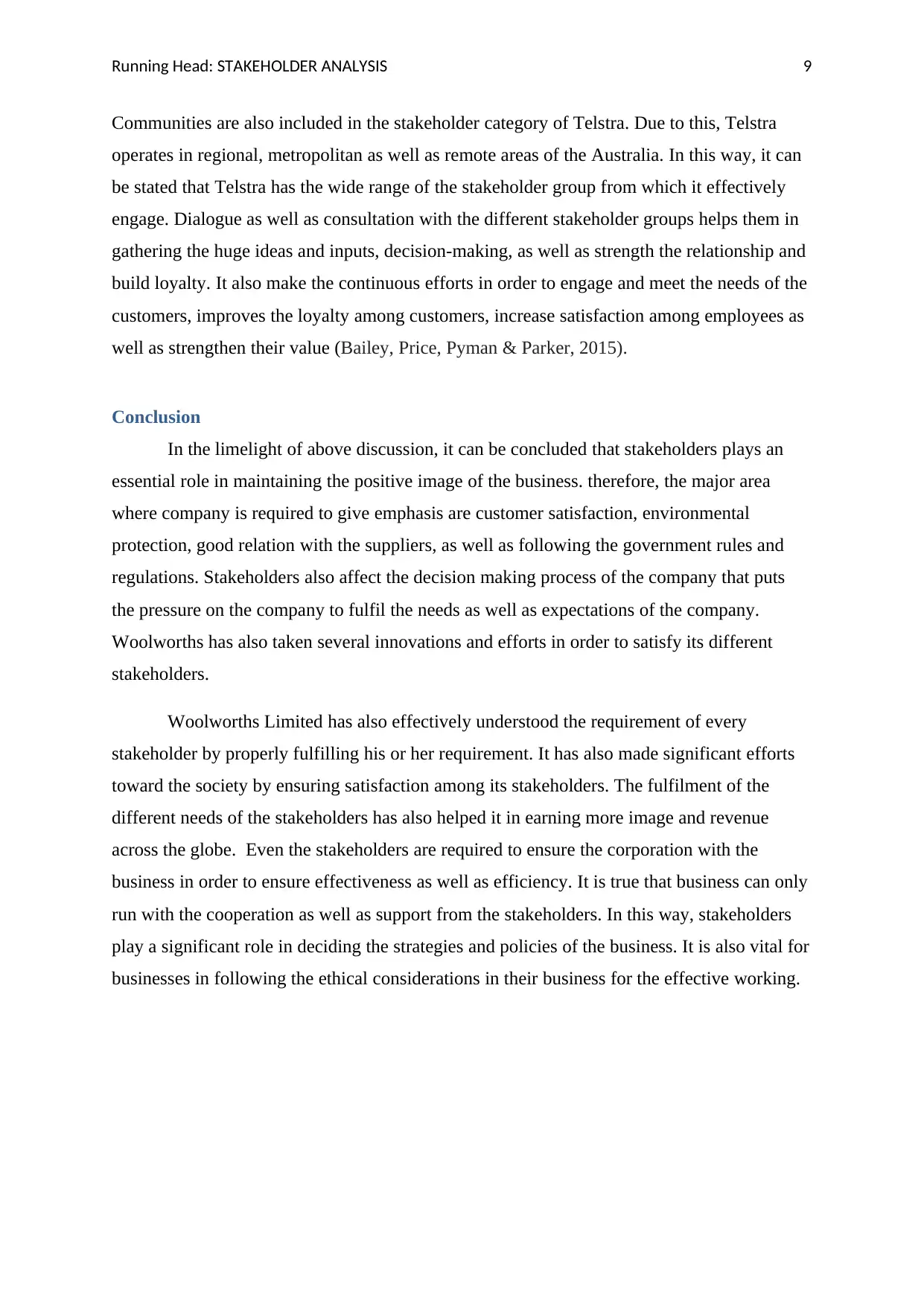
Running Head: STAKEHOLDER ANALYSIS 9
Communities are also included in the stakeholder category of Telstra. Due to this, Telstra
operates in regional, metropolitan as well as remote areas of the Australia. In this way, it can
be stated that Telstra has the wide range of the stakeholder group from which it effectively
engage. Dialogue as well as consultation with the different stakeholder groups helps them in
gathering the huge ideas and inputs, decision-making, as well as strength the relationship and
build loyalty. It also make the continuous efforts in order to engage and meet the needs of the
customers, improves the loyalty among customers, increase satisfaction among employees as
well as strengthen their value (Bailey, Price, Pyman & Parker, 2015).
Conclusion
In the limelight of above discussion, it can be concluded that stakeholders plays an
essential role in maintaining the positive image of the business. therefore, the major area
where company is required to give emphasis are customer satisfaction, environmental
protection, good relation with the suppliers, as well as following the government rules and
regulations. Stakeholders also affect the decision making process of the company that puts
the pressure on the company to fulfil the needs as well as expectations of the company.
Woolworths has also taken several innovations and efforts in order to satisfy its different
stakeholders.
Woolworths Limited has also effectively understood the requirement of every
stakeholder by properly fulfilling his or her requirement. It has also made significant efforts
toward the society by ensuring satisfaction among its stakeholders. The fulfilment of the
different needs of the stakeholders has also helped it in earning more image and revenue
across the globe. Even the stakeholders are required to ensure the corporation with the
business in order to ensure effectiveness as well as efficiency. It is true that business can only
run with the cooperation as well as support from the stakeholders. In this way, stakeholders
play a significant role in deciding the strategies and policies of the business. It is also vital for
businesses in following the ethical considerations in their business for the effective working.
Communities are also included in the stakeholder category of Telstra. Due to this, Telstra
operates in regional, metropolitan as well as remote areas of the Australia. In this way, it can
be stated that Telstra has the wide range of the stakeholder group from which it effectively
engage. Dialogue as well as consultation with the different stakeholder groups helps them in
gathering the huge ideas and inputs, decision-making, as well as strength the relationship and
build loyalty. It also make the continuous efforts in order to engage and meet the needs of the
customers, improves the loyalty among customers, increase satisfaction among employees as
well as strengthen their value (Bailey, Price, Pyman & Parker, 2015).
Conclusion
In the limelight of above discussion, it can be concluded that stakeholders plays an
essential role in maintaining the positive image of the business. therefore, the major area
where company is required to give emphasis are customer satisfaction, environmental
protection, good relation with the suppliers, as well as following the government rules and
regulations. Stakeholders also affect the decision making process of the company that puts
the pressure on the company to fulfil the needs as well as expectations of the company.
Woolworths has also taken several innovations and efforts in order to satisfy its different
stakeholders.
Woolworths Limited has also effectively understood the requirement of every
stakeholder by properly fulfilling his or her requirement. It has also made significant efforts
toward the society by ensuring satisfaction among its stakeholders. The fulfilment of the
different needs of the stakeholders has also helped it in earning more image and revenue
across the globe. Even the stakeholders are required to ensure the corporation with the
business in order to ensure effectiveness as well as efficiency. It is true that business can only
run with the cooperation as well as support from the stakeholders. In this way, stakeholders
play a significant role in deciding the strategies and policies of the business. It is also vital for
businesses in following the ethical considerations in their business for the effective working.
⊘ This is a preview!⊘
Do you want full access?
Subscribe today to unlock all pages.

Trusted by 1+ million students worldwide
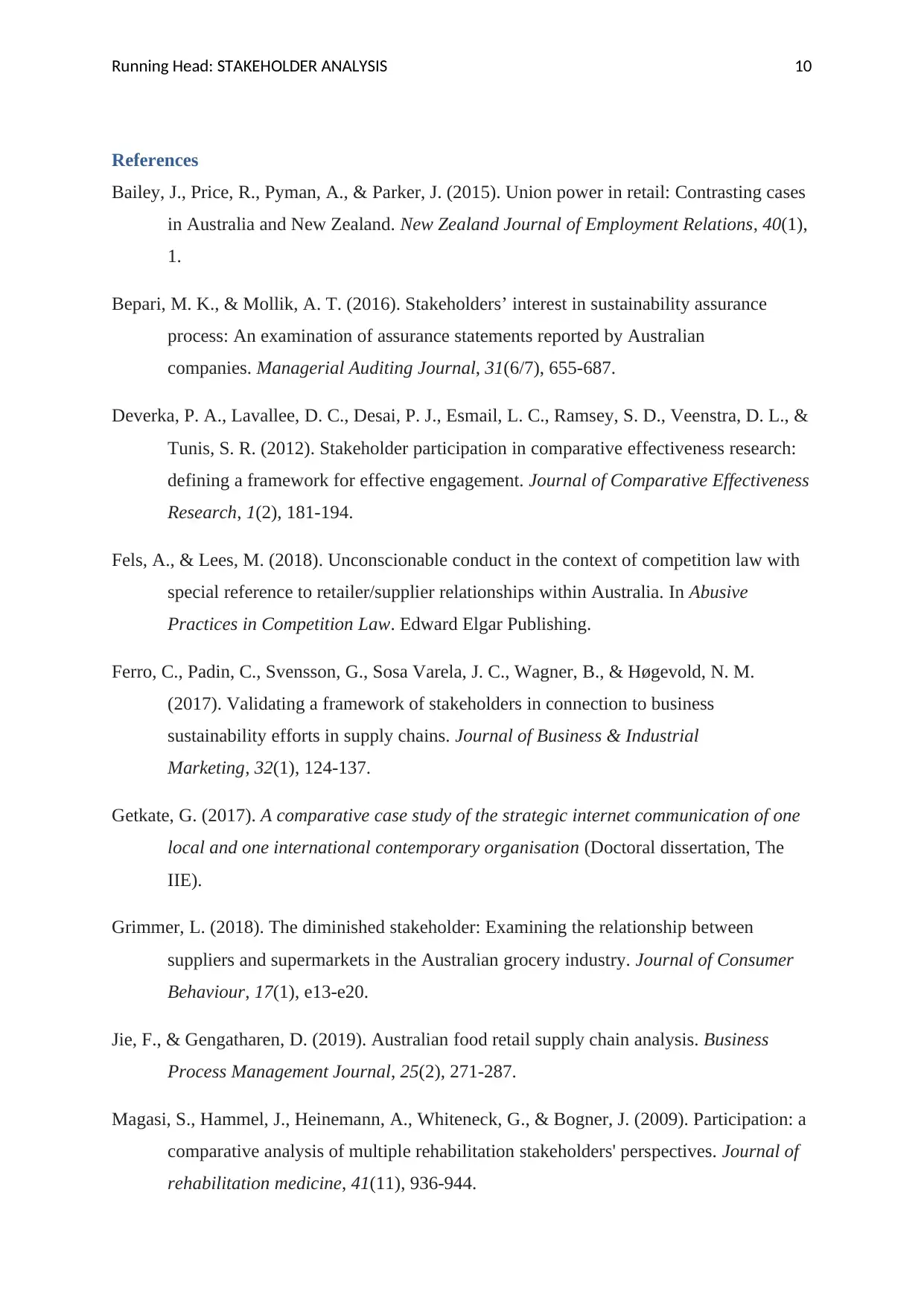
Running Head: STAKEHOLDER ANALYSIS 10
References
Bailey, J., Price, R., Pyman, A., & Parker, J. (2015). Union power in retail: Contrasting cases
in Australia and New Zealand. New Zealand Journal of Employment Relations, 40(1),
1.
Bepari, M. K., & Mollik, A. T. (2016). Stakeholders’ interest in sustainability assurance
process: An examination of assurance statements reported by Australian
companies. Managerial Auditing Journal, 31(6/7), 655-687.
Deverka, P. A., Lavallee, D. C., Desai, P. J., Esmail, L. C., Ramsey, S. D., Veenstra, D. L., &
Tunis, S. R. (2012). Stakeholder participation in comparative effectiveness research:
defining a framework for effective engagement. Journal of Comparative Effectiveness
Research, 1(2), 181-194.
Fels, A., & Lees, M. (2018). Unconscionable conduct in the context of competition law with
special reference to retailer/supplier relationships within Australia. In Abusive
Practices in Competition Law. Edward Elgar Publishing.
Ferro, C., Padin, C., Svensson, G., Sosa Varela, J. C., Wagner, B., & Høgevold, N. M.
(2017). Validating a framework of stakeholders in connection to business
sustainability efforts in supply chains. Journal of Business & Industrial
Marketing, 32(1), 124-137.
Getkate, G. (2017). A comparative case study of the strategic internet communication of one
local and one international contemporary organisation (Doctoral dissertation, The
IIE).
Grimmer, L. (2018). The diminished stakeholder: Examining the relationship between
suppliers and supermarkets in the Australian grocery industry. Journal of Consumer
Behaviour, 17(1), e13-e20.
Jie, F., & Gengatharen, D. (2019). Australian food retail supply chain analysis. Business
Process Management Journal, 25(2), 271-287.
Magasi, S., Hammel, J., Heinemann, A., Whiteneck, G., & Bogner, J. (2009). Participation: a
comparative analysis of multiple rehabilitation stakeholders' perspectives. Journal of
rehabilitation medicine, 41(11), 936-944.
References
Bailey, J., Price, R., Pyman, A., & Parker, J. (2015). Union power in retail: Contrasting cases
in Australia and New Zealand. New Zealand Journal of Employment Relations, 40(1),
1.
Bepari, M. K., & Mollik, A. T. (2016). Stakeholders’ interest in sustainability assurance
process: An examination of assurance statements reported by Australian
companies. Managerial Auditing Journal, 31(6/7), 655-687.
Deverka, P. A., Lavallee, D. C., Desai, P. J., Esmail, L. C., Ramsey, S. D., Veenstra, D. L., &
Tunis, S. R. (2012). Stakeholder participation in comparative effectiveness research:
defining a framework for effective engagement. Journal of Comparative Effectiveness
Research, 1(2), 181-194.
Fels, A., & Lees, M. (2018). Unconscionable conduct in the context of competition law with
special reference to retailer/supplier relationships within Australia. In Abusive
Practices in Competition Law. Edward Elgar Publishing.
Ferro, C., Padin, C., Svensson, G., Sosa Varela, J. C., Wagner, B., & Høgevold, N. M.
(2017). Validating a framework of stakeholders in connection to business
sustainability efforts in supply chains. Journal of Business & Industrial
Marketing, 32(1), 124-137.
Getkate, G. (2017). A comparative case study of the strategic internet communication of one
local and one international contemporary organisation (Doctoral dissertation, The
IIE).
Grimmer, L. (2018). The diminished stakeholder: Examining the relationship between
suppliers and supermarkets in the Australian grocery industry. Journal of Consumer
Behaviour, 17(1), e13-e20.
Jie, F., & Gengatharen, D. (2019). Australian food retail supply chain analysis. Business
Process Management Journal, 25(2), 271-287.
Magasi, S., Hammel, J., Heinemann, A., Whiteneck, G., & Bogner, J. (2009). Participation: a
comparative analysis of multiple rehabilitation stakeholders' perspectives. Journal of
rehabilitation medicine, 41(11), 936-944.
Paraphrase This Document
Need a fresh take? Get an instant paraphrase of this document with our AI Paraphraser
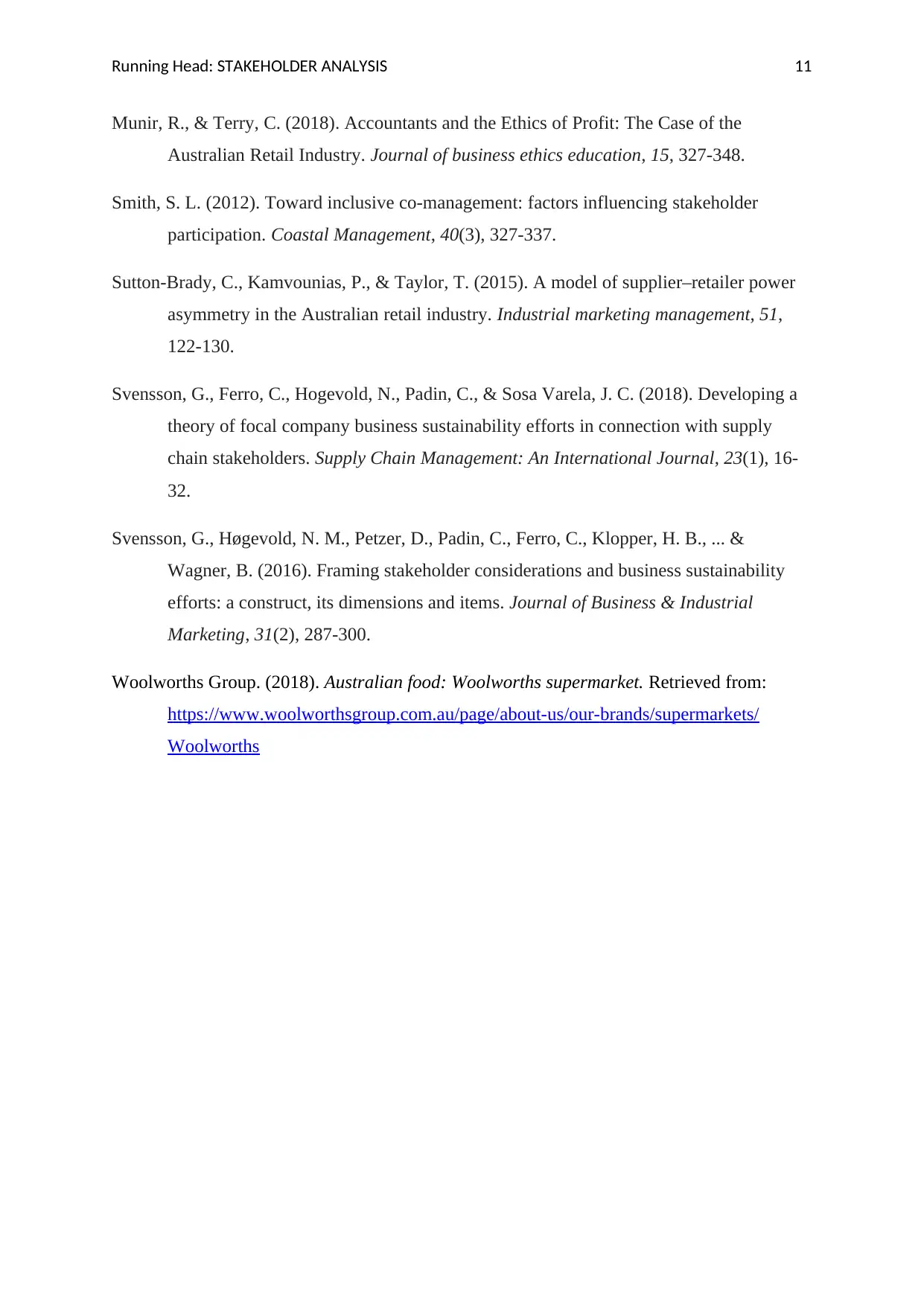
Running Head: STAKEHOLDER ANALYSIS 11
Munir, R., & Terry, C. (2018). Accountants and the Ethics of Profit: The Case of the
Australian Retail Industry. Journal of business ethics education, 15, 327-348.
Smith, S. L. (2012). Toward inclusive co-management: factors influencing stakeholder
participation. Coastal Management, 40(3), 327-337.
Sutton-Brady, C., Kamvounias, P., & Taylor, T. (2015). A model of supplier–retailer power
asymmetry in the Australian retail industry. Industrial marketing management, 51,
122-130.
Svensson, G., Ferro, C., Hogevold, N., Padin, C., & Sosa Varela, J. C. (2018). Developing a
theory of focal company business sustainability efforts in connection with supply
chain stakeholders. Supply Chain Management: An International Journal, 23(1), 16-
32.
Svensson, G., Høgevold, N. M., Petzer, D., Padin, C., Ferro, C., Klopper, H. B., ... &
Wagner, B. (2016). Framing stakeholder considerations and business sustainability
efforts: a construct, its dimensions and items. Journal of Business & Industrial
Marketing, 31(2), 287-300.
Woolworths Group. (2018). Australian food: Woolworths supermarket. Retrieved from:
https://www.woolworthsgroup.com.au/page/about-us/our-brands/supermarkets/
Woolworths
Munir, R., & Terry, C. (2018). Accountants and the Ethics of Profit: The Case of the
Australian Retail Industry. Journal of business ethics education, 15, 327-348.
Smith, S. L. (2012). Toward inclusive co-management: factors influencing stakeholder
participation. Coastal Management, 40(3), 327-337.
Sutton-Brady, C., Kamvounias, P., & Taylor, T. (2015). A model of supplier–retailer power
asymmetry in the Australian retail industry. Industrial marketing management, 51,
122-130.
Svensson, G., Ferro, C., Hogevold, N., Padin, C., & Sosa Varela, J. C. (2018). Developing a
theory of focal company business sustainability efforts in connection with supply
chain stakeholders. Supply Chain Management: An International Journal, 23(1), 16-
32.
Svensson, G., Høgevold, N. M., Petzer, D., Padin, C., Ferro, C., Klopper, H. B., ... &
Wagner, B. (2016). Framing stakeholder considerations and business sustainability
efforts: a construct, its dimensions and items. Journal of Business & Industrial
Marketing, 31(2), 287-300.
Woolworths Group. (2018). Australian food: Woolworths supermarket. Retrieved from:
https://www.woolworthsgroup.com.au/page/about-us/our-brands/supermarkets/
Woolworths
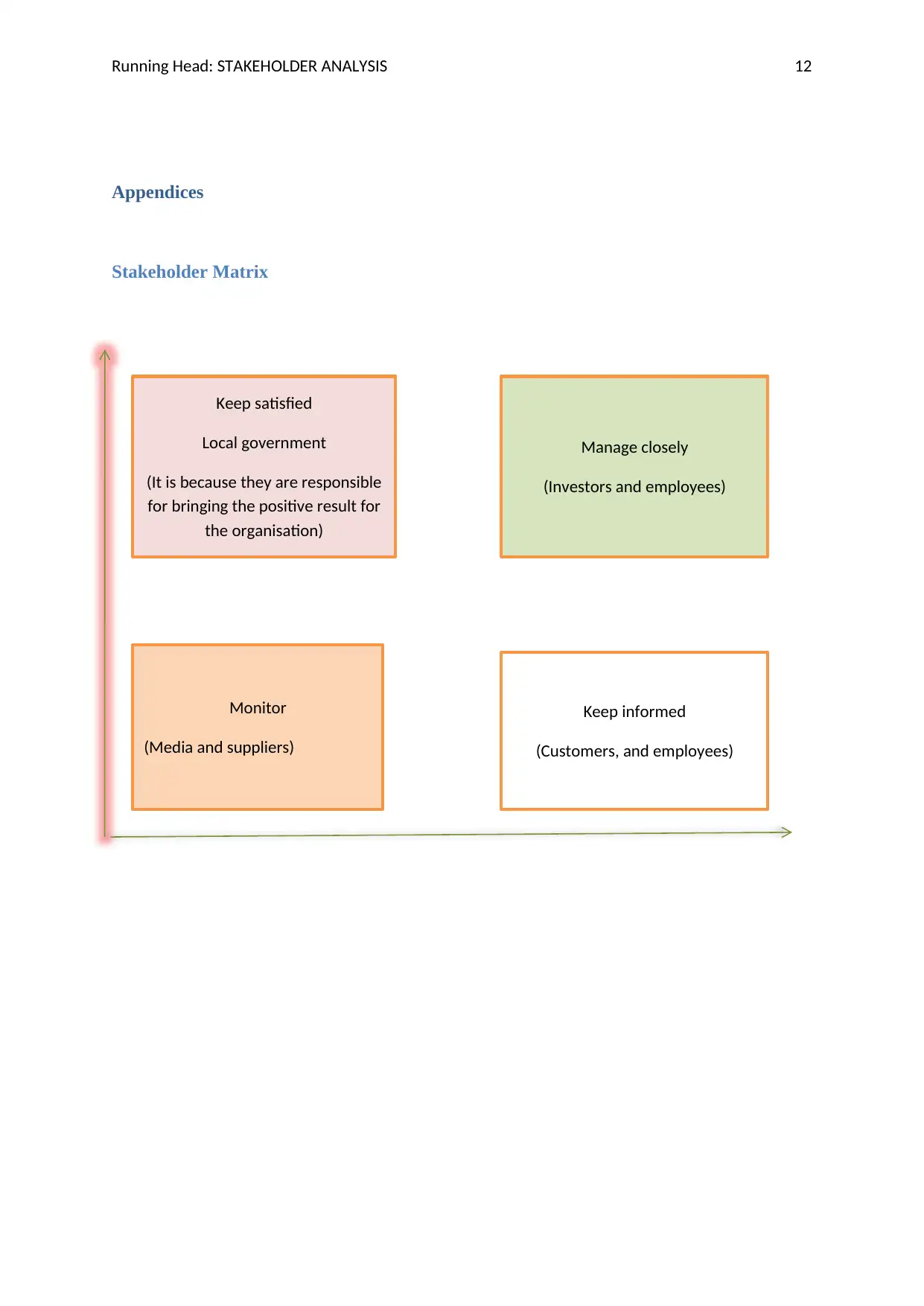
Running Head: STAKEHOLDER ANALYSIS 12
Appendices
Stakeholder Matrix
Keep satisfied
Local government
(It is because they are responsible
for bringing the positive result for
the organisation)
Manage closely
(Investors and employees)
Monitor
(Media and suppliers)
Keep informed
(Customers, and employees)
Appendices
Stakeholder Matrix
Keep satisfied
Local government
(It is because they are responsible
for bringing the positive result for
the organisation)
Manage closely
(Investors and employees)
Monitor
(Media and suppliers)
Keep informed
(Customers, and employees)
⊘ This is a preview!⊘
Do you want full access?
Subscribe today to unlock all pages.

Trusted by 1+ million students worldwide
1 out of 12
Related Documents
Your All-in-One AI-Powered Toolkit for Academic Success.
+13062052269
info@desklib.com
Available 24*7 on WhatsApp / Email
![[object Object]](/_next/static/media/star-bottom.7253800d.svg)
Unlock your academic potential
Copyright © 2020–2025 A2Z Services. All Rights Reserved. Developed and managed by ZUCOL.





